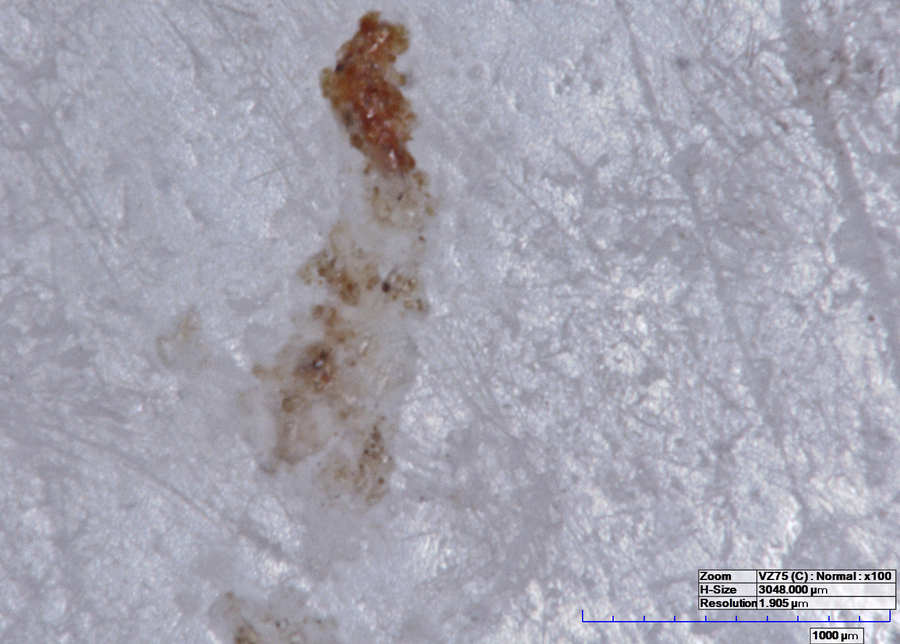Maximus
Summary
The examination of IN 823 ascertains that the polished marble portrait was painted in a delicate and detailed manner. The hair was painted in dark red nuances together with black underdrawing and small amounts of Egyptian blue. The original colouring of the eyes is poorly preserved but they were originally vividly coloured (for comparison see IN 821, IN 822 and IN 826). The highly-polished skin was also fully painted and red ochre and Egyptian blue have been identified as part of the carnation colour.
Description of object
The portrait, IN 823, is that of a clean-shaven young man with his hair cut short. The strands of hair are represented with a point and a flat chisel, creating a hatched, punctuated surface texture. The chisel is also used to accentuate the individual hairs of the eyebrows, while the pupils are drilled. The skin surface of the portrait is polished to a high gloss resembling porcelain, which stands in a sharp textural contrast to the chiselled hair.
The portrait is well preserved. However, it is broken by the neck and the nose and lips are missing. Parts of the ears are missing too. The left side of the face and hair is speckled with calcareous deposits.
Choice of methods
Visual examination
- Macroscopic
Technical imaging
- UV
- VIL
- Raking light
Sampling
- Thin section
- XRF
- Petrographic analysis
Marble identification method
- EPR and isotopes analysis
Visual examination
The hair shows traces of original layers of paint.On the hair above the left temple a compact, dark brownish-red layer is partly hidden beneath encrustation. A deep red layer on top of a black layer is found in the recess between two locks of hair at the neck. In addition, a finely painted curl directly superimposed on the polished skin part is documented just below the fringe.
Microscopy of the eyes and eyebrows reveals only a few, scattered particles of red and and black.
Carnation colour is in the main preserved as scattered particles of red. On the right cheek remnants of a cohesive orange-red layer, applied directly onto the polished marble surface.
Technical imaging
UV-FL: Fluorescent phenomena related to organic dyes or surface treatments are not observed.
VIL: On skin parts a few particles shining bright white are found. The majority of the particles are found in the nose breakage and on the neck. On the hair an even distribution of particles are observed suggesting that Egyptian blue was part of the hair’s original colour palette.
Other types of investigation
XRF: The brownish-red layer in the hair above the left temple is based on ochre (Fe, 5503 ppm) and smaller amounts of copper (Cu, 36 ppm), zinc (Zn, 70 ppm) and lead (Pb, 68 ppm). The red layer on top of a black layer contains the same mixture of ochre (Fe, 1385 ppm), copper (Cu, 24 ppm) zinc (Zn, 37 ppm) and lead (Pb, 36 ppm).
The eyes show traces of ochre (Fe, 681 ppm), zinc (Zn, 56 ppm) and lead (Pb, 34 ppm).
On the skin traces of colour consist of ochre, copper and zinc. However, the orange-red layer observed on the right cheek is different, containing only mercury (Hg, 12 ppm). It is, therefore, possible that cinnabar was part of the original carnation colour.
Bibliography
A. Skovmøller & R. Therkildsen (2011), On the High Gloss Polish of Roman Sculpture, in J.S.Østergaard (ed.). __Tracking __Colour, Preliminary Report 3, 2011. Ny Carlsberg Glyptotek, 35-46.
F. Johansen (1995), Roman Portraits III. Ny Carlsberg Glyptotek: Cat.no. 40, pp. 102-103
V. Poulsen (1974), Les Portaits Romains II. Ny Carlsberg Glyptotek, cat.no. 165.
- IN 823
- Portrait
- 235-238 C.E.
- Roman Imperial
- White Göktepe marble
- Acquired in 1892 from Martinetti in Rome, through the agency of Helbig.
- H. 42 cm.




















